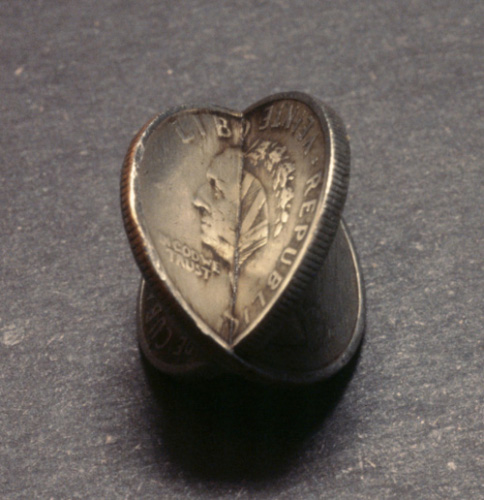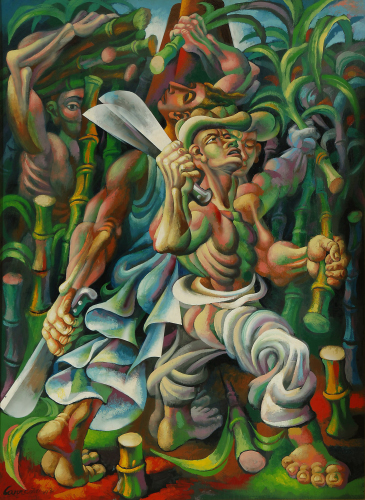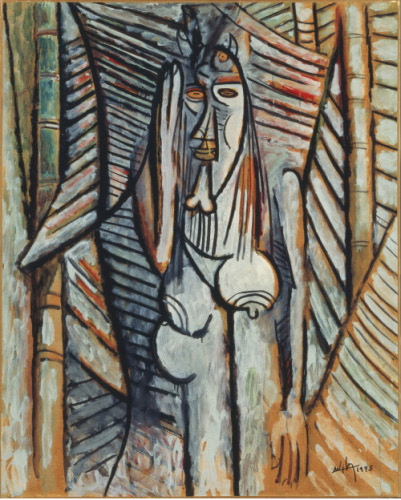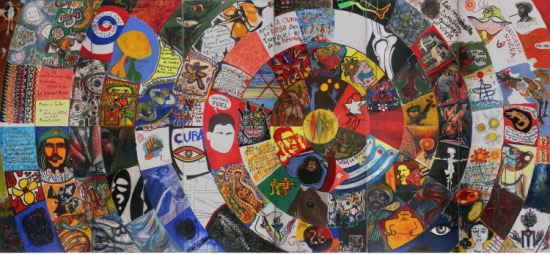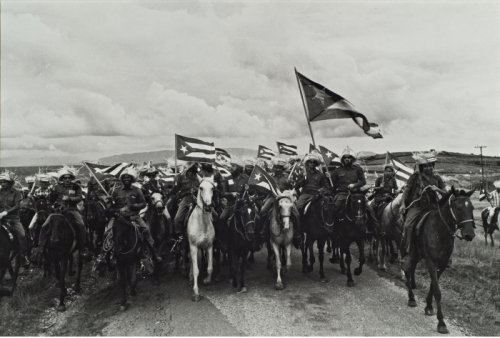Reconstruction 8.1 (2008)
Return to Contents»
"Cuba: Before the Hype" A Review of !Cuba: Art and History From 1868 to Today. Nathalie Bondil editor and curator, et al. Montreal Museum of Fine Art, January 31- June 8, 2008.
<1> When the Iron Curtain was thrown open, it revealed a treasure trove of cutting edge art in Cuba. The multimedia Post-Modern expressions quickly found their way into the New York galleries as well as those in Spain, London and France. Simultaneously, the Havana Biennales brought critics, curators and connoisseurs to Cuba to see their work; Cuban art reached a new stage of excitement and "hype". The world soon realized that the angst of politics, coupled by innovation, facilitated by the scarcity of materials, created an art with a profound commitment to intellectualization and relevance. The exhibition, States of Exchange: Artists from Cuba, in London January 23 – March 22, 2008 at the Institute of International Visual Arts (Iniva) brought together some of the Contemporary artists that we have come to admire such as Yoan Capote, along with some that are lesser known. It also brings together writers whose commentary has been read before, as well as fresh voices which are able to provide new insights.*
Yoan
Capote
Bilingual Money
US quarter and 20 cent Cuban coin
Courtesy of Institute of International Visual Arts (Iniva)
London, UK
Click Image for Larger Version
<2> However, few critics have explored the history of Cuban art in the same way, nor been able to put the art of our Contemporary society into a context that includes the Cuban Revolution, the Vanguard of Paris, and the Slave trade. The questions that are rarely asked about Cuban art are: Where did the ideas come from? How were they nurtured? What was the society that was able to support such discourse and advocate these unique and diverse expressions? Previously, the only way to learn about the entire history of Cuban art was to go to the Museo Nacional de Belles Artes in Havana and stroll through its newly renovated galleries where you would find the History of Cuban art as well as Contemporary Cuban art. The Montreal Museum of Fine Arts has taken on the monumental task of bringing that story to a broader audience by creating an exhibition on the art history of Cuba. Providing a context in which to place contemporary art, the exhibition in Montreal !Cuba: Art and History from 1868 to Today (January 31 – June 8, 2008) has brought more than 200 works of art that have never before been seen outside of Cuba, together with more than 200 works of art borrowed from museums and private collectors in the United States and elsewhere. The Montreal Museum then serves as a haven, standing staunchly between the factions of the U.S. embargo, to create a unique exhibition that allows thousands to come to understand Cuba through its own visualizations. The result is not actually a comprehensive display of the history of Cuban art, but a series of fascinating succinct exhibitions of key moments in Cuban history. The obvious and best known works of art may be absent, but the art that is present in its place is often that which has, but should not have been, forgotten. Those viewers familiar with contemporary Cuban art can now glimpse the historic icons that inspired the contemporary works.
<3> !Cuba, (the exhibition and its accompanying catalog of images and essays), begins with Ramos Domingo's enormous depiction of this lush tropical paradise. The visualization reminds us that before Cuba was associated with Fidel Castro it was known as the land of sandy shores and lush tropical forests. It also reminds the viewer of the tropical shores and sunshine of Tomas Sanchez, one of the best known Cuban artists of one hundred years later, who obviously also found his inspiration in the landscape of Cuba. Found in a later gallery, Sanchez' paintings explicate that relationship.
<4> Accompanying the lush landscapes are images of Africans and practitioners of their religion who, at the very same moment, were being forcibly transported into Cuba. Diablito by Landaluze was one of the first and best known images to document the spirit of the Abakuá. This male only brotherhood from the Calabar region of West Africa continues to today in Cuba and is the subject of the art of the contemporary artist, Belkis Ayon, whose art can also be found later in the exhibition.
<5> After visualizing the 19th century Cuban environment in paintings, the focus turns to the advent of photography in Cuba. Jose Marti stated that, "Photographs will people the world" and this statement reverberates throughout the exhibition in the extensive photographic sections. Known as a critic, literati, writer and provocateur, but also as a photojournalist, Jose Marti was a Cuban icon who is visualized perhaps almost as much as Che and probably more than Fidel Castro. Photography has in turn become one of the strongest art forms to emerge in Cuba, and the diverse collection in this exhibition lends credibility to its more recent relatives. The black and white images of the rich and elegant of the 1920s and 1950s contrast with the later images of Che, the revolutionary heroes marching in the streets of Havana, and then the digital imagery that also relates to politics, censorship, and the mass media influence.
<6> The colors are enlivened in the next gallery, as the influences of France and Italy become apparent; it is the Vanguard of Cuba [1]. Bright reds and yellows and greens are complimented by the sound of Afro Cuban drums and the big band jazz sounds which fill the air in a gallery that contains the art of Amelia Pelaez, Renee Portocarrero and Cundo Bermudez. These works of art, borrowed from the Museum of Modern Art as well as the Museo Nacional in Havana, are vibrant renditions of Cubism and Fauvism, but with a distinctly Cuban flair. The related photographs, postcards, music and large scale screen display of the big bands and vibrant dance, adds to the knowledge that these are not mere copies of the European avant-garde, but that it is an art infused with the spirit of Africa and sweltering heat of the Caribbean. The Sugar Cane Cutters, a rarely seen painting by Mario Carreño, is a new and vibrant rendition of Millet's Sower and its later copy by Van Gogh of The Sower with Setting Sun. The worker is pushed up against the picture plane, as he takes a giant stride to cut the cane; the worker has a distinctly Cuban identity that is no less heroicized than the common workers of the French Revolution.
Mario Carreño
Sugar-Cane Cutters, 1943
Duco on wood
Collection Isaac Carmen Lif and Family
Santo Domingo, Dominican Republic
Click Image for Larger Version
<7> Wifredo Lam's paintings has a voice uniquely his own and it is appropriate that Wifredo Lam receives a gallery for himself. His works are a perfect blend of European modernism and his own African inheritance. He succeeded in transforming the spirit of Africa into cubist shapes that resonate with the archetypal forms inherent in his heritage. For Wifredo Lam the politics of the almost 50 year-old U.S. embargo of Cuba ends in this gallery in Montreal and his art works are able to be united. This is a monumental feat, tearing apart an embargo that blocks the free exchange of cultural information and keeps all things Cuban from the U.S. and the US separated from Cuba. Examples of the great Lam collection at the Museum of Modern art are for the very first time joined together with those from the Museo Nacional. Although the great masterpieces from each collection are missing from this Lam display, (MoMA Jungle and Museo Nacional's Third World) it still maintains the breath of the artist's vision with exemplary, rarely seen pieces such as Mofumba (1943).
Wifredo Lam
The Murmur, 1943
Oil on paper mounted on canvas
Centre Georges Pompidou, Paris
Click Image for Larger Version
<8> Wifredo Lam's art sits physically between the new and the old, between the art, music and photography of pre-1959 and the art, posters, photographs of after the revolution. Lam's art sits in the museum at the precipice of the revolution because Lam was a supporter of the revolution. Some would like to change history and deny that support, but Lam not only visited Cuba on several occasions soon after the revolution, but organized a massive exposition to bring the Salon de Mai to Havana, inviting more than 100 friends, artists and writers to participate in an event of solidarity with Havana. The monumental mural that they collaboratively created is also on view in the Montreal Museum, albeit on another floor.
Collective, Havana
Salon de Mai Mural, 1967
Oil on canvas
Museo Nacionale de Bellas Artes,
Havana Cuba
Click Image for Larger Version
<9> This unique collaborative mural, created as part of the international exposition, was entitled Cuba Collectiva and began to take shape on the night of July 17, 1967. At Lam's suggestion, canvases were attached to a wooden grid. A spiral was drawn on the surface and the form was divided into approximately one hundred areas for painting. The center space was saved for Wifredo Lam, the organizer of the event. The artists who wrote images and painted images on the mural were the intelligencia and avant-garde of the world. They included Karel Appel, Willem de Kooning, Alexander Calder, Asger Jorn, René Magritte, Arp, Matta, Antoni Tápies, Vasarely, Pierre Soulages, and many others. Inter-generational, they represented various styles from a variety of countries, and yet they came together and wrote as well as visualized their celebration of the revolution. Although time may have changed some of their views, the display of this mural represents a moment in time when people believed that change was possible, and they came from all over the world to express that belief. The mural is accompanied by photographs of the event and copies of the brochures that were created at the time. This will be the longest that the mural will have ever been on display in one place. It was shown in Havana and Santiago de Cuba briefly, for 3-4 hours in Paris in May 1968, and most recently in Havana in 2004 after being restored in Paris. The display, as well as the photographs in the book, are a real contribution to not only understanding Cuban art, but also in understanding the camaraderie of the 1960s.
Collective, Havana
Salon de Mai Mural, 1967
Oil on canvas
Museo Nacionale de Bellas Artes,
Havana Cuba
Click Image for Larger Version
<10> The photographs of the heroes of the revolution, the marches, the rallies, the posters were created to visualize the revolution and bare witness to the revolution. The last few galleries of Cuba show the art after the revolution and it is generally more political than anything that had come before. The photos of Che or Raul Martinez' Pop art paintings are followed by art that at times was considered subversive. Antonia Eiriz' Tribunal installation was in storage for decades as was Lazaro Saavedra's Ideology Detector, and even today the political commentary can be understood. But in the Twenty-first Century they are both displayed proudly in the Museo Nacional, when they are not on loan in the Montreal Museum. .Similarly, a decade ago the Cuban authorities were reluctant to lend to shows that included those who had left Cuba -- that stance has obviously changed and was not an issue at all for this exhibition. This change in policy has enabled some of the artists who have left Cuba to be proudly displayed in this exhibition. The works shown here by Leandro Soto and Alejandro Aguilera are monuments to what has been referred to as the New Cuban art. Creating mixed media assemblage, La Familia Revolucionaria (1984) and Playitas y Granma, (1988) respectively, they create layers of meaning that speak to the façade of the established society versus the aspirations of the common Cuban. Filled with ironic metaphors best understood within a historic perspective, the new art was cutting edge and daring. As in the work of the next generation, nothing that is seen should be taken at face value.
<11> By the 1990s, as the iron curtain was pulled away, the concepts behind the art became more daring and engaging. The art of what has been euphemistically called the "Special Period" forever changed Cuba. After the Soviets left Cuba, and without the financial support of a super power, tourism became the engine that drove their economy. The Havana Biennales, the Ludwig Foundation, Art auctions, the renovated museum, the Ministry of Culture, all helped Cuba to realize the power of art to bring people to Cuba and to bring the Cubanidad to the world. To emerge from the economic crisis without any single country to lift them up, Cuban art emerged, was hyped and flourished. Tonel's massive concrete block reminds us of the pervasive presence of the U.S. blockade while Kcho's boat resting on a sea of beer bottles alludes to the balseros and the sentiment of isolation pervasive in contemporary Cuban culture just after the downing of the iron curtain.
<12> The last gallery represents the art of the last few years. It includes photography, painting and new media, both low tech and high tech. The Toirac Self Portrait reminds us of the photograph of Fidel at the beginning of the revolution, found in the other gallery. Toirac has made an art out of re-painting official documented images by deconstructing them into a parody of their former self. Humor and appropriation can also be found in his DVD projection entitled The Golden Age. Here Toirac juxtaposes the Elian Gonzalez tragedy with the endless pronouncements of politicians and the Press, children's books and Marti. Tania Bruguera presents a woman with her mouth wired open from her series Dream of Reason, while Lazaro Saavedra presents and updated version of the Ideology Detector with a DVD projection called Suspicion Syndrome, in which all eyes seem to be watching each other, questioning if the activity is permitted, subversive or counter-revolutionary.
<13> The exhibit ends, as it began, with a monumental work. Created by Carlos Garaicoa, this piece is not of the lush landscape but architectural structures made from candle molds and placed on a raised platform. Together they create a flickering, mesmerizing environment. These man made facades literally melt away to form a stream of wax as one monument melds into another.. Like the ruins of the ancient world, these are the remnants of the modern world, and of the human condition. The candles melt before us and the walls become rivers of understanding and global interaction. The isolated Caribbean Island has now become a part of the world and the artists of today's Cuba are in fact dealing with much more than tropical jungles and white sands. The Cuba that we see in this exhibition is the Cuba that inspired Columbus and Marti, Che and Breton. It also obviously inspired the Montreal Museum director and chief curator Nathalie Bondil to put together an exhibition that opens new doors to visualizing culture and politics.
<14> Cuba: Art and History From 1868-today is expansive, as is the accompanying 400+ page book. The book does not completely follow the exhibition and there are holes in the exhibition and book, (there is only one Mendive, and other major artists are missing), but it is the most exhaustive exhibition and catalogue to date. Together they underscore the need for a book that actually analyzes the individual works of art and puts Cuba into the context of the rest of the world. Most of the essays included in the catalogue provide only a summary of the various periods and a few of them seem as if they were rehashed from many other articles that the same authors had written on the same topic. Unfortunately, much of the art that they refer to in the articles is not in the exhibition, and much of the art in the exhibition is not mentioned. The book does, however, serve as a compendium of moments in history, and is replete with high quality images. The section on the Lam mural is a welcome introduction to the event of the mural, although even that essay fails to analyze the art that is actually in the mural. Cuban art will truly come of age when the individual works of art can stand on their own and be analyzed for their form, content and context. This exhibition and catalogue provides the entrée to that next step in understanding Cuba.
Note
[1] The art of the avant-garde is actually interrupted by a gallery of Walker Evans photographs of Cuba during the Machado era. Although they are powerful photographs, this intermediary display is disruptive to the flow of the exhibit (and Evans is not even Cuban). So I will choose to skip it as if it were a separate exhibition at the museum at the same time – which is what it should have been. [^]
Gail Gelburd
Return to Top»

